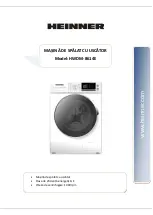
Troubleshooting
en
59
Fault
Cause and troubleshooting
Coloured coatings
(blue, yellow, brown)
that are difficult or im-
possible to remove
are present inside the
appliance or on stain-
less steel tableware.
The formation of films is due to substances contained
in vegetables (cabbage, celery, potatoes, noodles,
etc.) or tap water (manganese).
▶
Clean the appliance.
You can remove deposits with Mechanical cleaning
→
or a machine cleaning product. It may
not always be possible to completely remove de-
posits but they are harmless to health.
The formation of films is due to metal components on
silver or aluminium tableware.
▶
Clean the appliance.
You can remove deposits with Mechanical cleaning
→
or a machine cleaning product. It may
not always be possible to completely remove de-
posits but they are harmless to health.
Coloured deposits
(yellow, orange,
brown) that are easy
to remove are present
inside the appliance
(mainly at the bottom).
The formation of films is due to ingredients of food
remnants and tap water (limescale) "soaplike".
1.
Check the setting of the water softening system.
→
"Setting the water softening system", Page 31
2.
Add special salt.
→
"Adding special salt", Page 31
3.
If you are using combined detergents (tabs), activ-
ate the water softening system.
Follow the information on detergents.
→
"Information on detergents", Page 35
Plastic parts inside the
appliance are discol-
oured.
Plastic parts inside the appliance may become discol-
oured during the life of the dishwasher.
▶
Discolouration can come about and will not impair
functioning of the appliance.
Plastic parts are dis-
coloured.
Washing temperature is too low.
▶
Select a programme with a higher washing temper-
ature.
→
Tableware has been precleaned too intensely. The
sensors chose a weaker programme. Stubborn soiling
cannot be entirely removed.
▶
Only remove large remnants of food and do not
prerinse tableware.
▶
Adjust the sensitivity of the sensors.
→














































